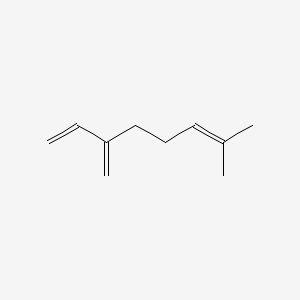| Authors | Title | Published | Journal | PubMed Link |
|---|---|---|---|---|
| Ciftci O et al. | Curcumin, myrecen and cineol modulate the percentage of lymphocyte subsets altered by 2,3,7, 8-tetracholorodibenzo-p-dioxins (TCDD) in rats. | 2011 | Hum Exp Toxicol | pmid:21450899 |
| Lucas PG | Regulating compassion: an overview of Canada's federal medical cannabis policy and practice. | 2008 | Harm Reduct J | pmid:18226254 |
| Sharifi MS et al. | Bio-activity of natural polymers from the genus Pistacia: a validated model for their antimicrobial action. | 2011 | Glob J Health Sci | pmid:22980106 |
| Soares-Castro P and Santos PM | Deciphering the genome repertoire of Pseudomonas sp. M1 toward β-myrcene biotransformation. | 2014 | Genome Biol Evol | pmid:25503374 |
| López MA et al. | Chemical composition and antigenotoxic properties of Lippia alba essential oils. | 2011 | Genet. Mol. Biol. | pmid:21931523 |
| Hyldgaard M et al. | Essential oils in food preservation: mode of action, synergies, and interactions with food matrix components. | 2012 | Front Microbiol | pmid:22291693 |
| Bevilacqua A et al. | Use of essential oils to inhibit alicyclobacillus acidoterrestris: a short overview of the literature. | 2011 | Front Microbiol | pmid:21991262 |
| Gomes-Carneiro MR et al. | Evaluation of beta-myrcene, alpha-terpinene and (+)- and (-)-alpha-pinene in the Salmonella/microsome assay. | 2005 | Food Chem. Toxicol. | pmid:15621337 |
| Mitić-Culafić D et al. | Protective effect of linalool, myrcene and eucalyptol against t-butyl hydroperoxide induced genotoxicity in bacteria and cultured human cells. | 2009 | Food Chem. Toxicol. | pmid:19049815 |
| Delgado IF et al. | Peri- and postnatal developmental toxicity of beta-myrcene in the rat. | 1993 | Food Chem. Toxicol. | pmid:8406238 |
| Delgado IF et al. | Study on embryo-foetotoxicity of beta-myrcene in the rat. | 1993 | Food Chem. Toxicol. | pmid:8444385 |
| Van Willige RW et al. | Influence of flavour absorption by food-packaging materials (low-density polyethylene, polycarbonate and polyethylene terephthalate) on taste perception of a model solution and orange juice. | 2003 | Food Addit Contam | pmid:12519723 |
| Arora R et al. | Potential of Complementary and Alternative Medicine in Preventive Management of Novel H1N1 Flu (Swine Flu) Pandemic: Thwarting Potential Disasters in the Bud. | 2011 | Evid Based Complement Alternat Med | pmid:20976081 |
| Amiri H | Essential oils composition and antioxidant properties of three thymus species. | 2012 | Evid Based Complement Alternat Med | pmid:21876714 |
| Duarte ID et al. | Analgesia by direct antagonism of nociceptor sensitization involves the arginine-nitric oxide-cGMP pathway. | 1992 | Eur. J. Pharmacol. | pmid:1330593 |
| Fischbach RJ et al. | Isolation and functional analysis of a cDNA encoding a myrcene synthase from holm oak (Quercus ilex L.). | 2001 | Eur. J. Biochem. | pmid:11683887 |
| Kauderer B et al. | Evaluation of the mutagenicity of beta-myrcene in mammalian cells in vitro. | 1991 | Environ. Mol. Mutagen. | pmid:1864266 |
| Pandey SK and Kim KH | An evaluation of volatile compounds released from containers commonly used in circulation of sports beverages. | 2011 | Ecotoxicol. Environ. Saf. | pmid:20832862 |
| Sarmento RA et al. | A herbivore that manipulates plant defence. | 2011 | Ecol. Lett. | pmid:21299823 |
| Chiang LC et al. | Antiviral activities of extracts and selected pure constituents of Ocimum basilicum. | 2005 | Clin. Exp. Pharmacol. Physiol. | pmid:16173941 |
Myrcene
Myrcene is a lipid of Prenol Lipids (PR) class. Myrcene is associated with abnormalities such as Hypomenorrhea, abnormal fragmented structure, Nephrosis, Renal tubular disorder and Kidney Diseases. The involved functions are known as Anabolism, Gene Expression, Protein Biosynthesis, Mutation and Selection, Genetic. Myrcene often locates in Plastids, Proboscis, Body tissue, Clone and soluble. The associated genes with Myrcene are TTPA gene, monoterpene synthase, Genome, 4S-limonene synthase and Homologous Gene. The related lipids are Pinene, Octanols, Membrane Lipids and Fatty Acids, Unsaturated.
Cross Reference
Introduction
To understand associated biological information of Myrcene, we collected biological information of abnormalities, associated pathways, cellular/molecular locations, biological functions, related genes/proteins, lipids and common seen animal/experimental models with organized paragraphs from literatures.
What diseases are associated with Myrcene?
Myrcene is suspected in Nephrosis, Kidney Diseases, Dehydration, Hypomenorrhea, Renal tubular disorder and other diseases in descending order of the highest number of associated sentences.
Related references are mostly published in these journals:
| Disease | Cross reference | Weighted score | Related literature |
|---|
No disease MeSH terms mapped to the current reference collection.
PubChem Associated disorders and diseases
What pathways are associated with Myrcene
There are no associated biomedical information in the current reference collection.
PubChem Biomolecular Interactions and Pathways
Link to PubChem Biomolecular Interactions and PathwaysWhat cellular locations are associated with Myrcene?
Visualization in cellular structure
Associated locations are in red color. Not associated locations are in black.
Related references are published most in these journals:
| Location | Cross reference | Weighted score | Related literatures |
|---|
What functions are associated with Myrcene?
Related references are published most in these journals:
| Function | Cross reference | Weighted score | Related literatures |
|---|
What lipids are associated with Myrcene?
Related references are published most in these journals:
| Lipid concept | Cross reference | Weighted score | Related literatures |
|---|
What genes are associated with Myrcene?
Related references are published most in these journals:
| Gene | Cross reference | Weighted score | Related literatures |
|---|
What common seen animal models are associated with Myrcene?
There are no associated biomedical information in the current reference collection.
